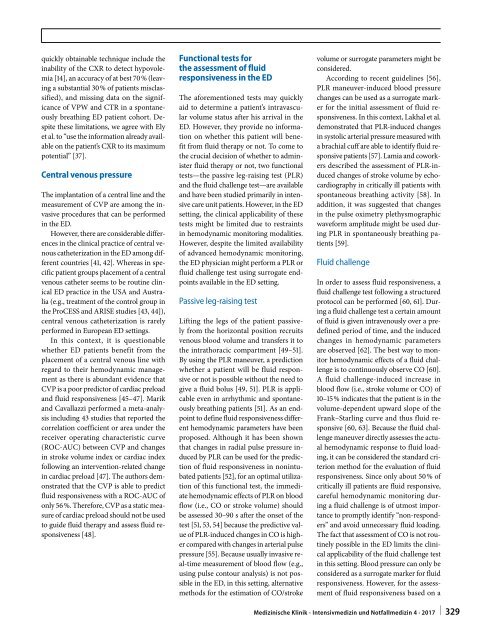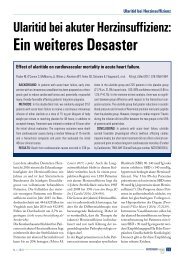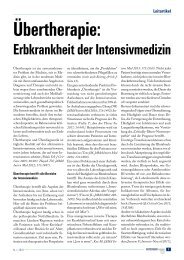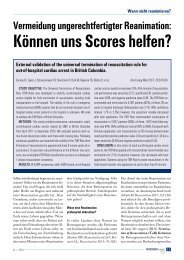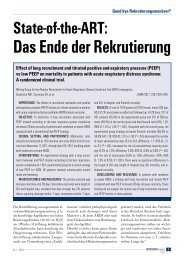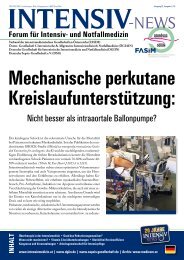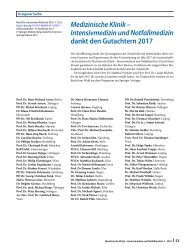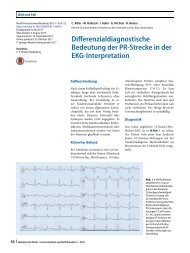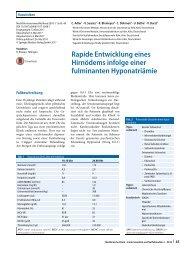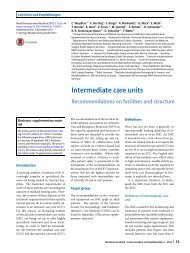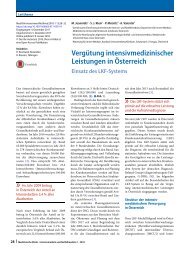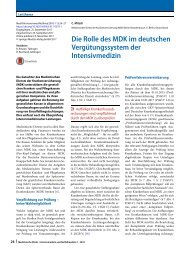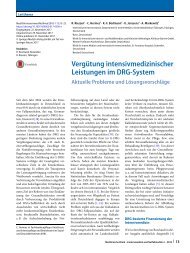08 Assessment of volume status and fluid responsiveness in the emergency department
Create successful ePaper yourself
Turn your PDF publications into a flip-book with our unique Google optimized e-Paper software.
quickly obta<strong>in</strong>able technique <strong>in</strong>clude <strong>the</strong><br />
<strong>in</strong>ability <strong>of</strong> <strong>the</strong> CXR to detect hypovolemia<br />
[14], an accuracy <strong>of</strong> at best 70 % (leav<strong>in</strong>g<br />
a substantial 30 % <strong>of</strong> patients misclassified),<br />
<strong>and</strong> miss<strong>in</strong>g data on <strong>the</strong> significance<br />
<strong>of</strong> VPW <strong>and</strong> CTR <strong>in</strong> a spontaneously<br />
breath<strong>in</strong>g ED patient cohort. Despite<br />
<strong>the</strong>se limitations, we agree with Ely<br />
et al. to “use <strong>the</strong> <strong>in</strong>formation already available<br />
on <strong>the</strong> patient’s CXR to its maximum<br />
potential” [37].<br />
Central venous pressure<br />
The implantation <strong>of</strong> a central l<strong>in</strong>e <strong>and</strong> <strong>the</strong><br />
measurement <strong>of</strong> CVP are among <strong>the</strong> <strong>in</strong>vasive<br />
procedures that can be performed<br />
<strong>in</strong> <strong>the</strong> ED.<br />
However, <strong>the</strong>re are considerable differences<br />
<strong>in</strong> <strong>the</strong> cl<strong>in</strong>ical practice <strong>of</strong> central venous<br />
ca<strong>the</strong>terization <strong>in</strong> <strong>the</strong> ED among different<br />
countries [41, 42]. Whereas <strong>in</strong> specific<br />
patient groups placement <strong>of</strong> a central<br />
venous ca<strong>the</strong>ter seems to be rout<strong>in</strong>e cl<strong>in</strong>ical<br />
ED practice <strong>in</strong> <strong>the</strong> USA <strong>and</strong> Australia<br />
(e.g., treatment <strong>of</strong> <strong>the</strong> control group <strong>in</strong><br />
<strong>the</strong> ProCESS <strong>and</strong> ARISE studies [43, 44]),<br />
central venous ca<strong>the</strong>terization is rarely<br />
performed <strong>in</strong> European ED sett<strong>in</strong>gs.<br />
In this context, it is questionable<br />
whe<strong>the</strong>r ED patients benefit from <strong>the</strong><br />
placement <strong>of</strong> a central venous l<strong>in</strong>e with<br />
regard to <strong>the</strong>ir hemodynamic management<br />
as <strong>the</strong>re is abundant evidence that<br />
CVP is a poor predictor <strong>of</strong> cardiac preload<br />
<strong>and</strong> <strong>fluid</strong> <strong>responsiveness</strong> [45–47]. Marik<br />
<strong>and</strong> Cavallazzi performed a meta-analysis<br />
<strong>in</strong>clud<strong>in</strong>g 43 studies that reported <strong>the</strong><br />
correlation coefficient or area under <strong>the</strong><br />
receiver operat<strong>in</strong>g characteristic curve<br />
(ROC-AUC) between CVP <strong>and</strong> changes<br />
<strong>in</strong> stroke <strong>volume</strong> <strong>in</strong>dex or cardiac <strong>in</strong>dex<br />
follow<strong>in</strong>g an <strong>in</strong>tervention-related change<br />
<strong>in</strong> cardiac preload [47]. The authors demonstrated<br />
that <strong>the</strong> CVP is able to predict<br />
<strong>fluid</strong> <strong>responsiveness</strong> with a ROC-AUC <strong>of</strong><br />
only 56 %. Therefore, CVP as a static measure<br />
<strong>of</strong> cardiac preload should not be used<br />
to guide <strong>fluid</strong> <strong>the</strong>rapy <strong>and</strong> assess <strong>fluid</strong> <strong>responsiveness</strong><br />
[48].<br />
Functional tests for<br />
<strong>the</strong> assessment <strong>of</strong> <strong>fluid</strong><br />
<strong>responsiveness</strong> <strong>in</strong> <strong>the</strong> ED<br />
The aforementioned tests may quickly<br />
aid to determ<strong>in</strong>e a patient’s <strong>in</strong>travascular<br />
<strong>volume</strong> <strong>status</strong> after his arrival <strong>in</strong> <strong>the</strong><br />
ED. However, <strong>the</strong>y provide no <strong>in</strong>formation<br />
on whe<strong>the</strong>r this patient will benefit<br />
from <strong>fluid</strong> <strong>the</strong>rapy or not. To come to<br />
<strong>the</strong> crucial decision <strong>of</strong> whe<strong>the</strong>r to adm<strong>in</strong>ister<br />
<strong>fluid</strong> <strong>the</strong>rapy or not, two functional<br />
tests—<strong>the</strong> passive leg-rais<strong>in</strong>g test (PLR)<br />
<strong>and</strong> <strong>the</strong> <strong>fluid</strong> challenge test—are available<br />
<strong>and</strong> have been studied primarily <strong>in</strong> <strong>in</strong>tensive<br />
care unit patients. However, <strong>in</strong> <strong>the</strong> ED<br />
sett<strong>in</strong>g, <strong>the</strong> cl<strong>in</strong>ical applicability <strong>of</strong> <strong>the</strong>se<br />
tests might be limited due to restra<strong>in</strong>ts<br />
<strong>in</strong> hemodynamic monitor<strong>in</strong>g modalities.<br />
However, despite <strong>the</strong> limited availability<br />
<strong>of</strong> advanced hemodynamic monitor<strong>in</strong>g,<br />
<strong>the</strong> ED physician might perform a PLR or<br />
<strong>fluid</strong> challenge test us<strong>in</strong>g surrogate endpo<strong>in</strong>ts<br />
available <strong>in</strong> <strong>the</strong> ED sett<strong>in</strong>g.<br />
Passive leg-rais<strong>in</strong>g test<br />
Lift<strong>in</strong>g <strong>the</strong> legs <strong>of</strong> <strong>the</strong> patient passively<br />
from <strong>the</strong> horizontal position recruits<br />
venous blood <strong>volume</strong> <strong>and</strong> transfers it to<br />
<strong>the</strong> <strong>in</strong>trathoracic compartment [49–51].<br />
By us<strong>in</strong>g <strong>the</strong> PLR maneuver, a prediction<br />
whe<strong>the</strong>r a patient will be <strong>fluid</strong> responsive<br />
or not is possible without <strong>the</strong> need to<br />
give a <strong>fluid</strong> bolus [49, 51]. PLR is applicable<br />
even <strong>in</strong> arrhythmic <strong>and</strong> spontaneously<br />
breath<strong>in</strong>g patients [51]. As an endpo<strong>in</strong>t<br />
to def<strong>in</strong>e <strong>fluid</strong> <strong>responsiveness</strong> different<br />
hemodynamic parameters have been<br />
proposed. Although it has been shown<br />
that changes <strong>in</strong> radial pulse pressure <strong>in</strong>duced<br />
by PLR can be used for <strong>the</strong> prediction<br />
<strong>of</strong> <strong>fluid</strong> <strong>responsiveness</strong> <strong>in</strong> non<strong>in</strong>tubated<br />
patients [52], for an optimal utilization<br />
<strong>of</strong> this functional test, <strong>the</strong> immediate<br />
hemodynamic effects <strong>of</strong> PLR on blood<br />
flow (i.e., CO or stroke <strong>volume</strong>) should<br />
be assessed 30–90 s after <strong>the</strong> onset <strong>of</strong> <strong>the</strong><br />
test [51, 53, 54] because <strong>the</strong> predictive value<br />
<strong>of</strong> PLR-<strong>in</strong>duced changes <strong>in</strong> CO is higher<br />
compared with changes <strong>in</strong> arterial pulse<br />
pressure [55]. Because usually <strong>in</strong>vasive real-time<br />
measurement <strong>of</strong> blood flow (e.g.,<br />
us<strong>in</strong>g pulse contour analysis) is not possible<br />
<strong>in</strong> <strong>the</strong> ED, <strong>in</strong> this sett<strong>in</strong>g, alternative<br />
methods for <strong>the</strong> estimation <strong>of</strong> CO/stroke<br />
<strong>volume</strong> or surrogate parameters might be<br />
considered.<br />
Accord<strong>in</strong>g to recent guidel<strong>in</strong>es [56],<br />
PLR maneuver-<strong>in</strong>duced blood pressure<br />
changes can be used as a surrogate marker<br />
for <strong>the</strong> <strong>in</strong>itial assessment <strong>of</strong> <strong>fluid</strong> <strong>responsiveness</strong>.<br />
In this context, Lakhal et al.<br />
demonstrated that PLR-<strong>in</strong>duced changes<br />
<strong>in</strong> systolic arterial pressure measured with<br />
a brachial cuff are able to identify <strong>fluid</strong> responsive<br />
patients [57]. Lamia <strong>and</strong> coworkers<br />
described <strong>the</strong> assessment <strong>of</strong> PLR-<strong>in</strong>duced<br />
changes <strong>of</strong> stroke <strong>volume</strong> by echocardiography<br />
<strong>in</strong> critically ill patients with<br />
spontaneous breath<strong>in</strong>g activity [58]. In<br />
addition, it was suggested that changes<br />
<strong>in</strong> <strong>the</strong> pulse oximetry plethysmographic<br />
waveform amplitude might be used dur<strong>in</strong>g<br />
PLR <strong>in</strong> spontaneously breath<strong>in</strong>g patients<br />
[59].<br />
Fluid challenge<br />
In order to assess <strong>fluid</strong> <strong>responsiveness</strong>, a<br />
<strong>fluid</strong> challenge test follow<strong>in</strong>g a structured<br />
protocol can be performed [60, 61]. Dur<strong>in</strong>g<br />
a <strong>fluid</strong> challenge test a certa<strong>in</strong> amount<br />
<strong>of</strong> <strong>fluid</strong> is given <strong>in</strong>travenously over a predef<strong>in</strong>ed<br />
period <strong>of</strong> time, <strong>and</strong> <strong>the</strong> <strong>in</strong>duced<br />
changes <strong>in</strong> hemodynamic parameters<br />
are observed [62]. The best way to monitor<br />
hemodynamic effects <strong>of</strong> a <strong>fluid</strong> challenge<br />
is to cont<strong>in</strong>uously observe CO [60].<br />
A <strong>fluid</strong> challenge-<strong>in</strong>duced <strong>in</strong>crease <strong>in</strong><br />
blood flow (i.e., stroke <strong>volume</strong> or CO) <strong>of</strong><br />
10–15 % <strong>in</strong>dicates that <strong>the</strong> patient is <strong>in</strong> <strong>the</strong><br />
<strong>volume</strong>-dependent upward slope <strong>of</strong> <strong>the</strong><br />
Frank–Starl<strong>in</strong>g curve <strong>and</strong> thus <strong>fluid</strong> responsive<br />
[60, 63]. Because <strong>the</strong> <strong>fluid</strong> challenge<br />
maneuver directly assesses <strong>the</strong> actual<br />
hemodynamic response to <strong>fluid</strong> load<strong>in</strong>g,<br />
it can be considered <strong>the</strong> st<strong>and</strong>ard criterion<br />
method for <strong>the</strong> evaluation <strong>of</strong> <strong>fluid</strong><br />
<strong>responsiveness</strong>. S<strong>in</strong>ce only about 50 % <strong>of</strong><br />
critically ill patients are <strong>fluid</strong> responsive,<br />
careful hemodynamic monitor<strong>in</strong>g dur<strong>in</strong>g<br />
a <strong>fluid</strong> challenge is <strong>of</strong> utmost importance<br />
to promptly identify “non-responders”<br />
<strong>and</strong> avoid unnecessary <strong>fluid</strong> load<strong>in</strong>g.<br />
The fact that assessment <strong>of</strong> CO is not rout<strong>in</strong>ely<br />
possible <strong>in</strong> <strong>the</strong> ED limits <strong>the</strong> cl<strong>in</strong>ical<br />
applicability <strong>of</strong> <strong>the</strong> <strong>fluid</strong> challenge test<br />
<strong>in</strong> this sett<strong>in</strong>g. Blood pressure can only be<br />
considered as a surrogate marker for <strong>fluid</strong><br />
<strong>responsiveness</strong>. However, for <strong>the</strong> assessment<br />
<strong>of</strong> <strong>fluid</strong> <strong>responsiveness</strong> based on a<br />
Mediz<strong>in</strong>ische Kl<strong>in</strong>ik - Intensivmediz<strong>in</strong> und Notfallmediz<strong>in</strong> 4 · 2017 |<br />
329


